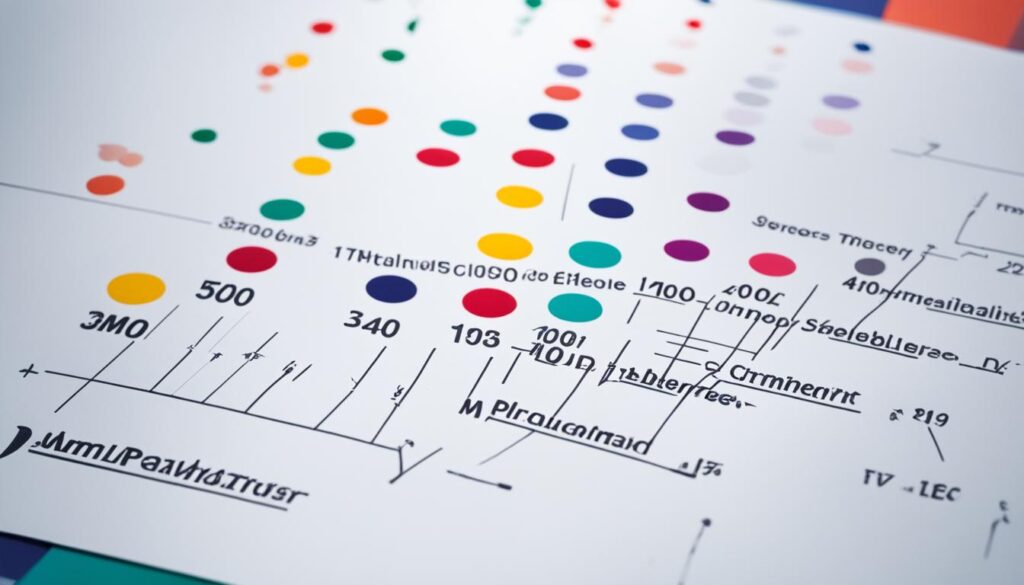Are you familiar with the fact that the Minnesota Multiphasic Personality Inventory (MMPI) is considered one of the most widely used psychological assessment tools worldwide? Its comprehensive approach to evaluating personality traits and psychopathology has made a significant impact on the fields of clinical psychology and mental health assessment.
Developed in the 1930s at the University of Minnesota, the MMPI continues to be a trusted tool for psychologists and psychiatrists in understanding an individual’s psychological makeup and aiding in diagnosis and treatment planning. Through its various versions, such as the MMPI-2 and MMPI-A, this personality test has been utilized in diverse settings and has evolved to meet the needs of different populations.
In this article, we will explore the origins and development of the MMPI, its significance in psychological assessment, the key features and components of the test, and its applications in various settings. We will also delve into the clinical and validity scales of the MMPI, understand how the MMPI-2 is utilized in psychological assessment, and explore the advancements and applications of the MMPI in recent years.
So, join us as we unravel the complexity of the Minnesota Multiphasic Personality Inventory and discover how it has revolutionized psychological assessment and diagnosis.
Key Takeaways:
- The Minnesota Multiphasic Personality Inventory (MMPI) is a widely used psychological assessment tool.
- The MMPI assesses personality traits and psychopathology and aids in diagnosing and planning treatments.
- It was developed in the 1930s and has undergone revisions and updates, resulting in versions such as the MMPI-2 and MMPI-A.
- The MMPI incorporates clinical and validity scales to provide a comprehensive assessment of various psychological characteristics.
- Mental health professionals utilize the MMPI in clinical psychology, research, forensic evaluations, and occupational screenings.
What is the Minnesota Multiphasic Personality Inventory (MMPI)?
The Minnesota Multiphasic Personality Inventory (MMPI) is a powerful psychological assessment tool used to measure various dimensions of an individual’s personality and psychopathology. Developed in the 1930s at the University of Minnesota, the MMPI has undergone revisions and updates over the years, making it a widely recognized and trusted instrument in the field of clinical psychology.
The MMPI plays a significant role in psychological assessment, providing valuable insights into an individual’s mental health, personality traits, and potential psychopathologies. It consists of a set of true/false questions that are designed to assess the test-taker’s thoughts, behaviors, emotions, and attitudes.
Origins and development of the MMPI
The MMPI was developed by psychologists Starke R. Hathaway and J.C. McKinley, with the aim of creating a reliable and standardized test to assess personality and psychopathology in a clinical setting. It was initially intended for use in psychiatric evaluations.
Significance of the MMPI in psychological assessment
The MMPI is widely recognized for its validity and reliability in psychological assessment. Its comprehensive nature allows mental health professionals to gather detailed information about an individual’s psychological profile, aiding in the diagnosis and treatment planning of mental health disorders.
Key features and components of the MMPI
The MMPI consists of multiple scales and measures that assess various aspects of personality and psychopathology. The test includes clinical scales, such as depression and schizophrenia, that measure specific psychopathologies, as well as validity scales that assess the test-taker’s response patterns and the validity of their answers.
Differences between MMPI-2 and MMPI-A
To cater to different populations, the MMPI has been adapted into different versions, such as the MMPI-2 for adults and the MMPI-A for adolescents. These versions include age-appropriate norms and scoring systems to ensure accurate assessment for specific age groups.
Application of the MMPI in different settings
The MMPI has various applications across different settings, including clinical psychology, research, forensic evaluations, and occupational screenings. It is used by mental health professionals to gain insights into an individual’s psychological functioning, aid in the diagnosis of mental health disorders, and guide treatment decisions.
Understanding the Clinical and Validity Scales of the MMPI
The Minnesota Multiphasic Personality Inventory (MMPI) utilizes clinical and validity scales to provide a comprehensive assessment of an individual’s psychological traits and psychopathologies. These scales play a critical role in interpreting the results of the MMPI and ensuring the accuracy and reliability of the assessment.
Overview of the Clinical Scales
The MMPI includes various clinical scales that measure specific aspects of psychopathology and personality functioning. These scales assess a range of psychological constructs, including hypochondriasis, depression, hysteria, and schizophrenia. Each scale provides valuable insights into an individual’s psychological functioning, helping mental health professionals identify potential diagnoses and develop effective treatment plans based on the MMPI results.
Role and Interpretation of Validity Scales
Validity scales within the MMPI assess the test-taker’s response patterns and the validity of their responses. These scales are crucial in identifying potential exaggeration or underreporting and ensuring the validity of the test results. Mental health professionals rely on these validity scales to gauge the reliability and truthfulness of the individual’s responses, thus enhancing the accuracy of the psychological assessment.
Interpreting MMPI-2 Clinical Scales
The MMPI-2, which is a revised version of the MMPI for adult personality assessment, incorporates clinical scales that parallel those found in the original MMPI. Mental health professionals interpret the scores on these clinical scales to gain a deeper understanding of an individual’s psychological functioning, including personality traits and psychopathologies.
Comparing MMPI Clinical Scales and MMPI-2 Clinical Scales
While the MMPI and MMPI-2 share similar clinical scales, there are some differences between the two versions. The MMPI-2 has more comprehensive scales, updated norms, and refined item content. Mental health professionals consider these differences when interpreting the scores and providing an accurate assessment using the MMPI-2.
Use of MMPI-2 in Clinical Practice
In clinical practice, mental health professionals commonly utilize the MMPI-2 due to its extensive use in psychological assessment. The MMPI-2 provides valuable insights into an individual’s psychological functioning, aiding in the diagnosis and treatment planning of various mental health disorders. Mental health professionals employ the clinical and validity scales of the MMPI-2 to assess an individual’s psychological traits, identify potential psychopathologies, and develop personalized treatment strategies.

How the MMPI-2 is Utilized in Psychological Assessment
The MMPI-2, a version of the Minnesota Multiphasic Personality Inventory specifically designed for adult personality assessment, plays a crucial role in psychological assessment and clinical practice. Mental health professionals utilize the MMPI-2 to gather valuable information about an individual’s personality traits, psychopathologies, and overall psychological functioning.
The interpretation of MMPI-2 test results is done by comparing them to a normative sample, which provides a baseline for accurate assessment. This comparison allows health professionals, such as clinical psychologists and psychiatrists, to gain insights into an individual’s psychological characteristics and diagnose specific psychopathologies.
In the process of administering the MMPI-2, health professionals guide individuals through the test and ensure accurate completion. Subsequently, they interpret the results, taking into account the individual’s responses and the scale scores derived from those responses. These results provide valuable insights into personality traits, offering a comprehensive understanding of an individual’s psychological profile.
Moreover, the MMPI-2 allows for the assessment of specific psychopathologies, aiding in the diagnosis of mental health disorders. By analyzing scale scores related to various psychopathological dimensions, health professionals can identify clinically significant symptoms and make informed treatment decisions.

Applications of the MMPI-2 in Psychological Assessment
| Setting | Application |
|---|---|
| Clinical Psychology | Diagnosis and assessment of personality disorders |
| Research | Examining psychological traits and psychopathologies in various populations |
| Forensic Evaluations | Assessing the psychological profiles of individuals involved in legal cases |
| Occupational Screenings | Evaluating psychological suitability for specific job roles |
The MMPI-2’s versatility and comprehensive assessment capabilities make it a valuable tool for mental health professionals in various settings. By utilizing the MMPI-2, health professionals can gain valuable insights into an individual’s psychological characteristics, identify psychopathologies, and make informed decisions regarding diagnosis and treatment.
Exploring the Advancements and Applications of the MMPI
Evolution of the MMPI with the introduction of MMPI-2 and MMPI-A
Over the years, the MMPI has undergone significant advancements leading to the development of newer versions specifically tailored for adult and adolescent psychological assessment. The introduction of the MMPI-2 and MMPI-A has revolutionized psychological testing and evaluation, addressing the limitations of the original MMPI and incorporating updated scales and norms.
The MMPI-2 is a revised version that provides a more comprehensive and accurate assessment of an individual’s psychological profile. It includes additional scales and measures that enhance the identification of specific psychopathologies and personality traits. This expanded version has become a staple in clinical practice, research, and forensic evaluations, offering valuable insights into various psychological disorders and aiding in treatment planning.
The MMPI-A, on the other hand, is specifically designed for adolescent psychological assessment. Recognizing the unique developmental considerations during adolescence, the MMPI-A incorporates age-appropriate questions and norms, ensuring accurate assessment and interpretation of psychological functioning in this population. This version has found widespread application in educational settings, clinical practice, and research involving adolescent mental health.
Understanding the restructured forms of the MMPI-2 and MMPI-A
The restructured forms of the MMPI-2 and MMPI-A have further improved the interpretation and clinical utility of these tests. The restructuring process involved refining the scales and subscales, eliminating redundant items, and optimizing the interpretation of the results. These changes have resulted in streamlined assessments, enhancing the efficiency and reliability of the MMPI-2 and MMPI-A.
Adapting the MMPI for use in adolescent psychological assessment
The adaptation of the MMPI for use in adolescent psychological assessment was a significant development in the field. Adolescence is a critical period marked by unique psychological challenges and developmental changes. The MMPI-A addresses these specific needs by tailoring the test to assess age-related psychopathology, personality traits, and behavioral patterns. Its adaptation has enabled mental health professionals to gain valuable insights into the psychological well-being and potential risks faced by adolescents.
Insights into the development and application of newer versions of the MMPI
The development and application of newer versions of the MMPI have greatly expanded the scope and impact of psychological assessment. These advancements have allowed for more accurate diagnoses, targeted interventions, and improved patient outcomes. Mental health professionals continue to explore the potential of the MMPI and its versions in various clinical and research settings, driving further research, innovation, and refinement in psychological assessment techniques.

As we delve into the advancements and applications of the MMPI, it becomes evident that this psychological assessment tool has come a long way. With the introduction of the MMPI-2 and MMPI-A, the MMPI has become an indispensable instrument in understanding the complexities of human psychology across different age groups. The evolution of the MMPI, coupled with the restructured forms tailored for specific populations, has enhanced its efficacy in clinical practice, research, forensic evaluations, and occupational screenings. As mental health professionals continue to embrace and explore the newer versions of the MMPI, the field of psychological assessment is poised to benefit from improved accuracy, targeted interventions, and a deeper understanding of psychological functioning.
Key Considerations and Interpretations in MMPI Testing
When conducting MMPI testing, there are several key considerations and interpretations that need to be taken into account. These aspects are crucial for accurately assessing an individual’s psychological characteristics and providing meaningful insights into their personality and psychopathology.
Assessing raw scores and scales in the MMPI
One of the primary steps in MMPI testing involves assessing raw scores and scales. Raw scores represent the total number of endorsed items within a particular scale, providing objective data about an individual’s psychological traits. The MMPI consists of various scales, each measuring a specific dimension, such as depression, hypochondriasis, paranoia, and social introversion. Analyzing the raw scores in these scales helps clinicians gain a comprehensive understanding of an individual’s personality profile.
Understanding the interpretation of high scores in specific MMPI scales
High scores in specific MMPI scales can provide valuable insights into potential personality disorders and psychopathologies. For example, a high score in the depression scale may indicate symptoms of depression, while a high score in the paranoia scale may suggest paranoid tendencies. Interpretation of these high scores requires clinical expertise and an understanding of the context and individual’s history. It is important to consider the interplay between different scales and not rely solely on individual scale scores.
Insights into the assessment of personality disorders using MMPI
The MMPI is a useful tool for assessing personality disorders. By analyzing scale scores and patterns, clinicians can identify specific diagnostic criteria and assess the presence and severity of personality disorders such as borderline personality disorder, narcissistic personality disorder, or antisocial personality disorder. This assessment allows for accurate diagnosis and more targeted treatment planning.
Exploring the clinical use of MMPI test items and content scales
The clinical use of MMPI test items and content scales provides valuable information about an individual’s psychological functioning. Test items cover a wide range of topics, including feelings, thoughts, behaviors, and attitudes. Clinicians can analyze the responses to these items to gain insights into an individual’s psychological strengths, weaknesses, and maladaptive behavior patterns. Content scales, such as the psychopathic deviate scale or the hysteria scale, offer additional information about specific aspects of an individual’s personality and psychopathology.
Guidelines for clinicians when using MMPI and MMPI-2 for personality assessment
When using the MMPI and MMPI-2 for personality assessment, clinicians should follow specific guidelines to ensure proper use and accurate interpretation. These guidelines include administering the test in a standardized and consistent manner, considering the cultural and individual differences of the test-taker, and integrating the results with other clinical assessments and information. Clinicians should also be aware of potential limitations and biases in the test and interpret the results within the broader context of the individual’s history and clinical presentation.

Overall, understanding key considerations and interpretations in MMPI testing is essential for conducting accurate personality assessments and providing valuable insights into an individual’s psychological characteristics. The assessment of raw scores and scales, interpretation of high scores, assessment of personality disorders, clinical use of test items and content scales, and following guidelines for clinicians contribute to a comprehensive and meaningful MMPI evaluation.
Conclusion
In conclusion, the Minnesota Multiphasic Personality Inventory (MMPI) is an invaluable tool in the field of psychological assessment. It provides comprehensive insights into an individual’s personality traits, psychopathologies, and overall psychological functioning. The MMPI has been widely utilized in various settings, including clinical psychology, research, forensic evaluations, and occupational screenings.
Mental health professionals play a crucial role in administering the MMPI and interpreting the results. Their expertise ensures accurate assessments and appropriate treatment planning based on the individual’s unique psychological profile. With ongoing advancements and applications, the MMPI continues to refine and enhance psychological assessment practices, ultimately contributing to improved patient care and better mental health outcomes.
By utilizing the various versions of the MMPI, such as the MMPI-2 and MMPI-A, clinicians are equipped with a powerful tool that aids in understanding and diagnosing psychological conditions. The availability of normative samples and the delineation of specific scales and scores in the MMPI-2 allows for precise interpretations and a comprehensive assessment of an individual’s mental health. Furthermore, the continuous development of the MMPI ensures that it remains at the forefront of psychological assessment, providing valuable insights into personality traits and psychopathologies.
FAQ
What is the Minnesota Multiphasic Personality Inventory (MMPI)?
The MMPI is a widely used psychometric test that assesses personality traits and psychopathology. It is utilized in various settings, including clinical psychology and psychiatric evaluations, to provide insights into an individual’s psychological characteristics and aid in diagnosis and treatment planning.
What are the origins and development of the MMPI?
The MMPI was developed in the 1930s at the University of Minnesota. It has undergone revisions and updates over the years to improve its accuracy and relevance in psychological assessment.
What are the key features and components of the MMPI?
The MMPI consists of true/false questions and incorporates clinical and validity scales. The clinical scales measure specific aspects of psychopathology and personality functioning, while the validity scales assess the test-taker’s response patterns and the validity of their responses.
What are the differences between MMPI-2 and MMPI-A?
The MMPI-2 is a version of the MMPI designed for adult personality assessment, while the MMPI-A is tailored for adolescent assessment. These versions address the specific needs of different age groups and incorporate updated scales and norms.
Where is the MMPI applied in different settings?
The MMPI is widely utilized in clinical psychology, research, forensic evaluations, and occupational screenings to assess personality traits, psychopathologies, and overall psychological functioning.
How are the clinical and validity scales of the MMPI interpreted?
The clinical scales measure specific aspects of psychopathology, and the validity scales ensure the accuracy and reliability of the assessment. Mental health professionals use the scales to gain insights into an individual’s psychological functioning, identify potential diagnoses, and develop treatment plans.
How is the MMPI-2 utilized in psychological assessment?
The MMPI-2 is used by mental health professionals to gather information about an individual’s personality traits, psychopathologies, and overall psychological functioning. Interpretation of MMPI-2 test results is done in comparison to a normative sample for accurate assessment.
What are the advancements and applications of the MMPI?
Over the years, the MMPI has evolved, witnessing the introduction of newer versions like the MMPI-2 and MMPI-A. These advancements have expanded the applications of the MMPI in various settings, contributing to improved psychological assessment and diagnosis.
What are the key considerations and interpretations in MMPI testing?
During MMPI testing, clinicians assess raw scores and scales, interpret high scores in specific scales to identify potential personality disorders and psychopathologies, and utilize MMPI test items and content scales for valuable information. Following guidelines ensures proper use and accurate interpretation of the MMPI.
Augustus is the visionary leader and Editor-in-Chief of Personality-Test.net. With an unwavering commitment to quality and authenticity, he oversees all content, ensuring it enlightens and empowers our audience. Augustus believes deeply in the transformative power of self-awareness and is dedicated to making Personality-Test.net a beacon for those on a journey to understand themselves better.










